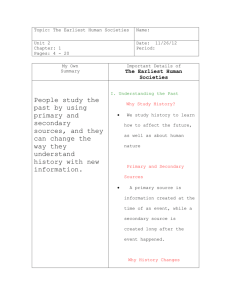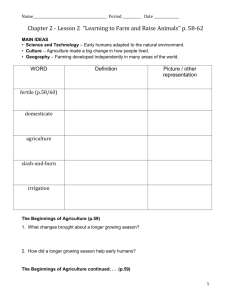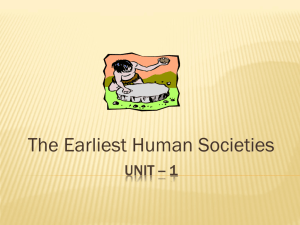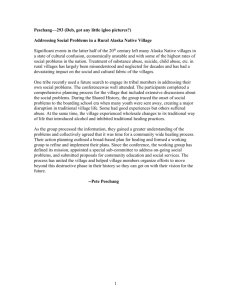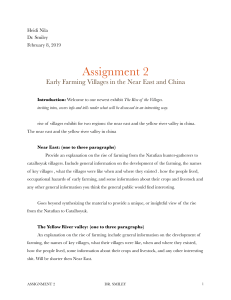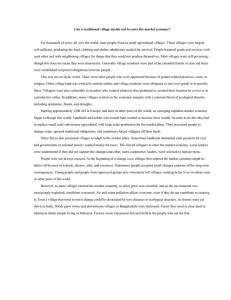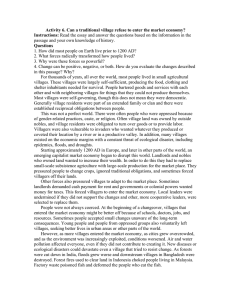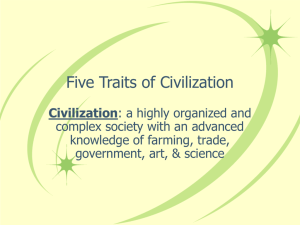Ch. 2 – The Earliest Human Societies Lesson 1 – Hunters
advertisement
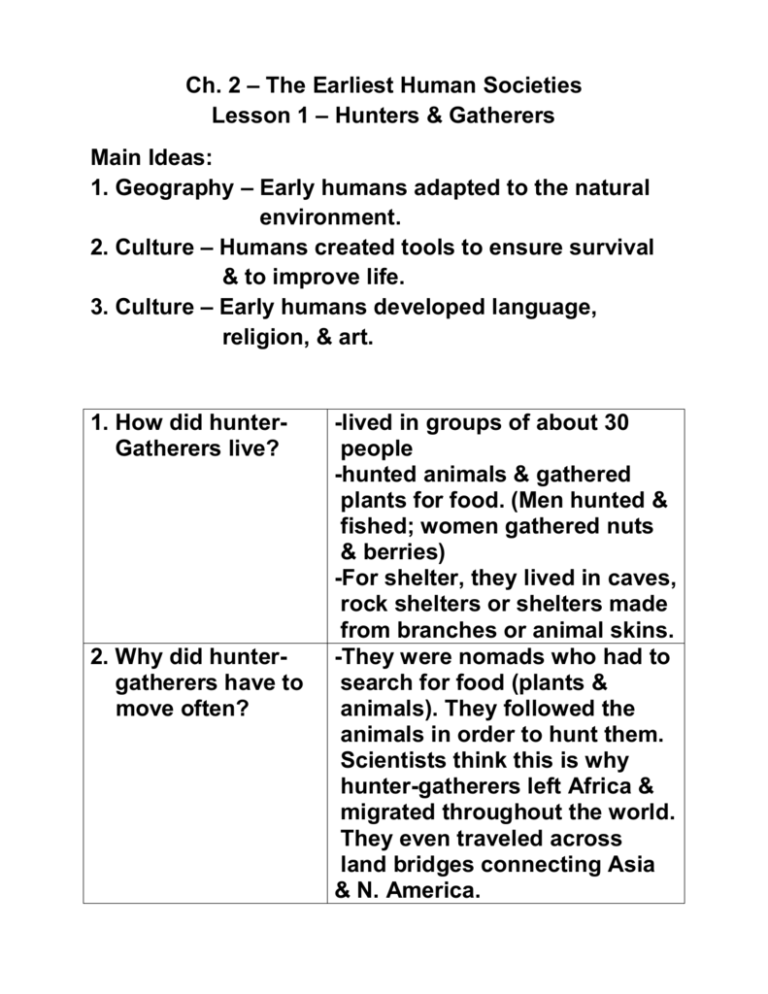
Ch. 2 – The Earliest Human Societies Lesson 1 – Hunters & Gatherers Main Ideas: 1. Geography – Early humans adapted to the natural environment. 2. Culture – Humans created tools to ensure survival & to improve life. 3. Culture – Early humans developed language, religion, & art. 1. How did hunterGatherers live? 2. Why did huntergatherers have to move often? -lived in groups of about 30 people -hunted animals & gathered plants for food. (Men hunted & fished; women gathered nuts & berries) -For shelter, they lived in caves, rock shelters or shelters made from branches or animal skins. -They were nomads who had to search for food (plants & animals). They followed the animals in order to hunt them. Scientists think this is why hunter-gatherers left Africa & migrated throughout the world. They even traveled across land bridges connecting Asia & N. America. 3. What are the positive/negative effects of migration? Positive: When groups meet, they can share knowledge & tools. Negative: They may fight w/ each other. 4. How did When people developed more technology give complex tools, they could use humans more the materials around them to control over their make better hunting tools & environment? tools to make shelters. This way they could work more efficiently & make themselves comfortable & safe. 5. How did language Language made it easier for help make hunters people to work together & to more successful? cooperate, which would increase the success of the hunt. 6. How were religion & art connected for early people? Art was a way for early people to communicate their spiritual beliefs. Art includes painting, music, dance, & storytelling. Lesson 2 – Learning to Farm & Raise Animals Main Ideas: 1. Sci. & Tech. – New technologies supported an agricultural revolution. 2. Culture – Agriculture made a big change in how people lived. 3. Geography – Farming developed independently in many areas of the world. 7. Why did early They raised animals so they people domesticate would have reliable source of animals? food.They also made clothing from skins & tools & weapons from bones. Some animals provided labor. Dogs helped with hunting & herding. Horses & donkeys were used for farming. 8. How did people 1st they noticed that grain domesticate plants? sprouted from seeds. They started to loosen soil, dig holes, & plant seeds. Then they planted seeds from the best of the crop. 9. What factors led to People wanted to stay close to the settlement of where the land was fertile & villages? they found that there was more safety in larger numbers. 10. Were there any disadvantages to village life? Yes. There was always a risk of fire, disease, & flood. 11. Where did farming develop? Early villages in China & Africa grew along rivers. Later, these farmers were the 1st to use irrigation systems that moved water from the rivers using a sys. of dikes & canals. Lesson 3 – The First Communities Main Ideas: 1. Culture – Some simple farming villages expanded & developed into more complex villages. 2. Culture – Early forms of gov’t, specialized workers, & social classes began to develop in complex villages. 3. Culture – The way of life in a complex village was diff. from that in a simple farming village. 12. How did surpluses change the way people lived? 13. What is specialization? 14. How did religion develop? When the village had more food than it needed, not everyone was needed to raise food. Also, surpluses of food & other materials helped villages survive seasons when less food & materials were produced. It is skill in one kind of work. Potters & weavers were probably the 1st to specialize. People who specialized traded their products for food. People trained in skills & crafts were called artisans. Some people explained natural events (rain, fire, or earthquakes) to others. They also explained the meaning 15. How did early forms of gov’t develop? 16. What do we know about the village of Catal Huyuk? of a good or bad harvest. These people were considered as holy & they later became priests of the 1st cities. Since people were living in large villages, they needed laws & leadership to keep order & settle disagreements. It dates from about 7000 B.C. About 5,000 people lived in brick buildings that were built close together. Some bldgs. were used for religious ceremonies. We know that the people specialized because mirrors, metal beads, cloth, pottery, & wooden bowls were found. There was evidence of trade. Also, there were wall paintings.

